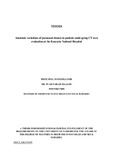| dc.description.abstract | Objective: To determine radiologic variants of paranasal air sinuses among patients undergoing CT scan evaluation at KNH. To determine demographic characteristics of patients requiring paranasal CT scanning at KNH.
Study Design: Prospective cross sectional study Methods: This is a prospective cross sectional study that was conducted at the Department of Radiology in Kenyatta National Hospital comprising of 100 patients’ computed tomography scans of paranasal sinuses. The machine that was used is Phillips Brilliance CT scanner, 16 slice. Model 45356702331, serial number 729. CT scans were taken in axial plane and then three millimeter slices reconfigured into coronal and sagittal planes. Anatomical variants assessed are agger nasi, haller cells, onodi cells, concha bullosa, and deviated nasal septum. Other uncommon variants were also detected.Study duration: From October 2013 and completion will be in October 2014.
Data Management and Analysis: The data collected was transferred into Microsoft Access database and then analyzed using STATA version 13 (Stata Corp, College Station, Texas) statistical software. Descriptive analysis was used to determine the means, frequencies and proportions of the various anatomical variations. The proportions of the various anatomical variations further have the 95% CI. Results are presented in the form of tables and graphs together with their descriptions.
Results: Sample size of 100 patients, 56 females and 44 males. Of the common variants, 91(91%) patients have agger nasi cells, 13(13%) patients have haller cells, 44(44%) patients have concha bullosa, 41(41%) patients have onodi cells while 16(16%) have septal nasal deviation.
Of the uncommon variants, maxillary sinus hypoplasia was identified in 1(1%) patient.
Superior concha bullosa was identified in 4(4%) patients. Inferior concha bullosa was identified in 1(1%) patient. Bilateral paradoxical middle turbinate was present in 5(5%) patients.Paradoxical superior turbinate was present in the right in 1(1%) patient. Septate sphenoid was present in 14(14%) patients.
Keros type 1 in 25(25%) patients; keros type 2 in 67(67%) patients, keros type 3 in 7(7%) patients and keros type 4 in 1(1%) patient.
Conclusion: anatomical variations are best viewed and appreciated in the coronal plane. The Keros classification of olfactory fossa depth is best calculated in coronal plane. Both sagittal and axial planes don’t give adequate information with regards to the anatomy of paranasal sinuses and the presence of anatomical variations.
Gender had significant correlation (Pearson chi-square p-value=0.043) with Onodi cell, which implied that the variant was mainly dominant on males as compared to females | en_US |
| dc.description.department | a
Department of Psychiatry, University of Nairobi, ; bDepartment of Mental Health, School of Medicine,
Moi University, Eldoret, Kenya | |

